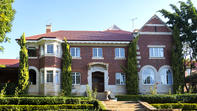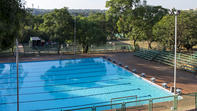New Afrikaans School
In 1922, with the deepening division between Smuts's pro-English South African Party and Hertzog's pro-Afrikaans National Party, the decision was taken to bring an end to the dual-medium status of the high school.

A new school was built on the flat land on the other side of the railway lines, and it was here that the new Afrikaans Hoärseunskool ('Affies') was started in the early 1920s. All was not lost, however: the two schools have been good neighbours and friendly rivals for almost 70 years, the sporting encounters between them - especially in rugby - the highlights of their sports calendars.
Pretoria Boys' High School has in fact been playing rugby since its earliest days, unlike its Johannesburg counterparts where soccer was the winter game until about 1932.
Early records show the school teams playing in the Pretoria senior leagues: in 1909 the team played in the third league and won; later the boys played in the second league, and by 1918 they had moved into the first league.
In spite of its successes at and enthusiasm for the game, the only Springbok rugby player produced by the school was Nico Bonsma, in 1924. After 1932 the school's opponents included the Johannesburg schools, but the Afrikaans Hoärseunskool remains its great rival.
New Headmaster
Enrolment dropped at the school following the departure of the Afrikaans-speaking boys, but within a year the vacuum was filled. The other English-language high school in Tshwane, the White House High School, was closed and its pupils transferred to Pretoria Boys' High School.
Scottish-born Daniel Duff Matheson was the next headmaster of the school, taking over the reins in 1935. Quite different in character from his predecessor, Matheson was a strong and stern father figure, but tempered this with a warmth and friendliness that enabled him to keep control of a large number of independent-minded boys - under him enrolment grew from 450 to nearly 800.
Matheson, who left in 1949, is commemorated by a drinking fountain outside the sports pavilion that was designed by well-known Pretoria architect Norman Eaton. The fountain was erected in 1960 as the school's tribute to a fine headmaster.
Sporting Achievements

Another Scot, Noel M Pollock, took over from Matheson as headmaster of the school in 1950. He was the first Old Boy to be appointed to the position. During his six years as headmaster, extensive additions and alterations to the school made his task extremely difficult from an organisational point of view.
Nonetheless, his hard work at keeping up the school's morale and maintaining achievements at a high level was rewarded in his final year, 1955, when the best-ever matric results were achieved, and the 1st cricket team went through the season unbeaten in inter school matches.
This was, in fact, the era that spawned a series of Pretoria Boys' High School Springbok cricketers, including Ken Funston, Eddie Barlow (who was also a first-class rugby player), Syd Burke, Glen Hall and Jackie Botten.
The Art Master
Desmond Abernethy was the next headmaster of Pretoria Boys' High School. Born in Ireland in 1908, Desmond had come to South Africa as a child with his family in 1919. Desmond and Dermot, his youngest brother, both attended the White House High School until it closed down and then, with the rest of the pupils from the White House, transferred to Pretoria Boys' High in 1925.
Desmond Abernethy went on to teach for 16 years at King Edward VII School in Johannesburg, and was then appointed Inspector. In 1955 the pending vacancy of headmaster at his alma mater came up and Abernethy jumped at it, describing his move as a 'downwards promotion'.
Abernethy's long term of office was an eventful one in terms of the development of the school, and by the time he left in 1973 enrolment had reached an all-time high of 1 000. Art became a popular and important subject at the school in the 1950s. The art master at that time was the famous and eccentric Walter Battiss, who left to take up a professorship at the University of South Africa (Unisa), and was succeeded by another well-known contemporary artist, Larry Scully. After Scully came Clinton Harrop-Allin, who followed in Battiss's footsteps to a professorship at Unisa. Among the noted artists produced by the school are Zakkie Eloff, noted stamp designer Dick Findlay, and Frank Rosen, RA.
Music is similarly important at the school today, and is offered as a matric subject. There is an 80-piece symphony orchestra, a senior choir, a junior choir, a folk group, a brass band, a pipe band and a nine-piece Dixie band, the last-named unique in South African schools. A renowned musician who is an Old Boy of the school is conductor Leo Quayle.
Malcolm Armstrong
In the early 1960s large-scale renovations and extensions took place at the school, including the building of new classrooms and laboratories, and, most importantly, a new school hall. The attractive old hall was demolished and in its place a spacious entrance foyer to the school was created on ground level, while on the first floor staff rooms and a library.
A new utilitarian hall was added on, twice as large as the old one and with greatly improved facilities. Although the loss of the old hall, so much a part of the school's history and beloved by Old Boys, staff and pupils, was regretted, it could no longer accommodate the school, nor could it provide the modern amenities demanded of a leading educational institution.
Malcolm Armstrong was the school's eighth headmaster, and only the second who was South African-born. Under Armstrong, the school's already excellent academic standards improved, to the point that in his last year there, 1989, just under 90 per cent of Pretoria Boys' matriculants achieved their university entrance certificates. Armstrong's belief was that a school should provide for its pupils a systematic and disciplined intellectual training but also encourage creativity. This was made concrete by the number of extramural clubs and societies that sprang up during his tenure.
Today his legacy lives on in the angling club, the bridge club, the chess club, the debating society, the first-aid team, the lepidopterist society, the students' Christian association, the students' Jewish association and the wildlife society, to name but a few.
In 1990, Bill Schroder became headmaster. A former head prefect of Rondebosch Boys High, Mr Schroder was a positive headmaster who embraced change. Schroder's challenge was to maintain the extraordinary levels of excellence that have been achieved at the school, and to add some extra lustre - and he went the extra hurdle of maintaining these standards through the uncertain times that lay ahead, with the financing and administration of the school a much greater responsibility than ever before.